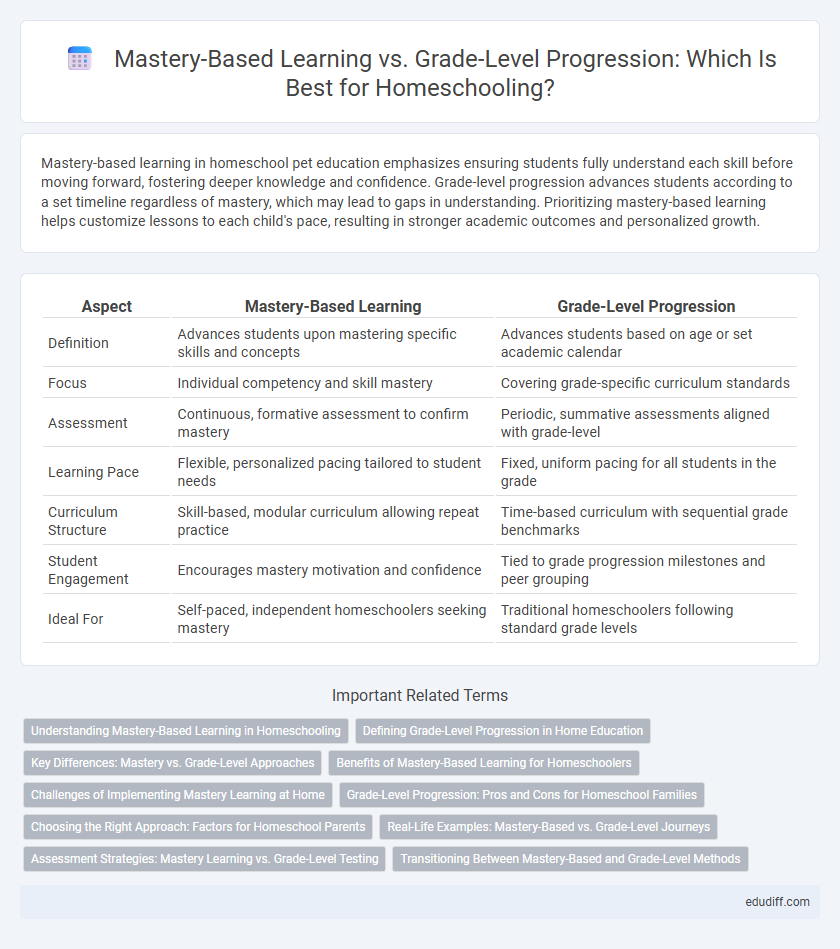Mastery-based learning in homeschool pet education emphasizes ensuring students fully understand each skill before moving forward, fostering deeper knowledge and confidence. Grade-level progression advances students according to a set timeline regardless of mastery, which may lead to gaps in understanding. Prioritizing mastery-based learning helps customize lessons to each child's pace, resulting in stronger academic outcomes and personalized growth.
Table of Comparison
| Aspect | Mastery-Based Learning | Grade-Level Progression |
|---|---|---|
| Definition | Advances students upon mastering specific skills and concepts | Advances students based on age or set academic calendar |
| Focus | Individual competency and skill mastery | Covering grade-specific curriculum standards |
| Assessment | Continuous, formative assessment to confirm mastery | Periodic, summative assessments aligned with grade-level |
| Learning Pace | Flexible, personalized pacing tailored to student needs | Fixed, uniform pacing for all students in the grade |
| Curriculum Structure | Skill-based, modular curriculum allowing repeat practice | Time-based curriculum with sequential grade benchmarks |
| Student Engagement | Encourages mastery motivation and confidence | Tied to grade progression milestones and peer grouping |
| Ideal For | Self-paced, independent homeschoolers seeking mastery | Traditional homeschoolers following standard grade levels |
Understanding Mastery-Based Learning in Homeschooling
Mastery-based learning in homeschooling emphasizes students fully understanding concepts before moving on, contrasting with traditional grade-level progression that advances students on a fixed schedule regardless of comprehension. This approach allows personalized pacing, ensuring learners build a strong foundation and retain knowledge more effectively. Homeschooling environments uniquely support mastery learning by adapting curriculum and assessment to individual student needs and strengths.
Defining Grade-Level Progression in Home Education
Grade-level progression in home education refers to advancing students through a standardized curriculum based on age-specific grade benchmarks, following traditional school year increments. This approach emphasizes meeting predetermined academic standards and pacing aligned with typical grade expectations, regardless of individual student mastery. In contrast, it allows homeschooling parents to structure learning according to familiar educational milestones while maintaining flexibility in content delivery.
Key Differences: Mastery vs. Grade-Level Approaches
Mastery-based learning emphasizes students demonstrating a thorough understanding of specific skills before advancing, ensuring depth of knowledge and personalized pacing. Grade-level progression follows a fixed curriculum timeline where students move through standards collectively, regardless of mastery. This contrast highlights mastery's focus on competency and individualized learning versus the standardized benchmarks of grade-level progression.
Benefits of Mastery-Based Learning for Homeschoolers
Mastery-based learning allows homeschoolers to progress at their own pace, ensuring deep understanding of subjects before moving forward, which leads to stronger retention and confidence. This approach tailors education to individual strengths and weaknesses, promoting personalized skill development and reducing frustration often caused by rigid grade-level expectations. Homeschoolers benefit from mastery-based learning by achieving academic competency that aligns with real-world applications rather than arbitrary time constraints.
Challenges of Implementing Mastery Learning at Home
Implementing mastery-based learning in homeschooling presents challenges such as accurately assessing mastery without standardized tools and maintaining consistent motivation for self-paced progress. Parents often struggle to design curriculum that adapts to individual learning speeds while ensuring coverage of essential grade-level standards. Limited access to resources and expert guidance can hinder personalized feedback, crucial for mastery learning success.
Grade-Level Progression: Pros and Cons for Homeschool Families
Grade-level progression in homeschool settings offers a clear, structured pathway aligned with traditional education benchmarks, making it easier for families to track academic milestones and prepare students for transitions into public or private schools. This method simplifies curriculum planning by using standardized grade-specific materials, yet it may restrict individualized pacing and limit opportunities for advanced learners or those needing more time in certain subjects. Homeschool families must weigh the benefits of consistency and comparability against potential challenges in addressing unique student needs when following grade-level progression.
Choosing the Right Approach: Factors for Homeschool Parents
Homeschool parents must evaluate individual student needs, learning pace, and subject mastery when choosing between Mastery-Based Learning and Grade-Level Progression. Mastery-Based Learning emphasizes comprehension and skill acquisition before advancement, which benefits students requiring personalized pacing. Grade-Level Progression aligns with traditional schooling timelines, supporting structured curriculum delivery and standardized assessment benchmarks.
Real-Life Examples: Mastery-Based vs. Grade-Level Journeys
Mastery-based learning in homeschooling allows students to progress at their own pace, focusing on complete understanding of subjects like math or language arts before moving on, exemplified by a student mastering fractions through hands-on cooking projects. In contrast, grade-level progression follows a fixed timeline where a child moves to the next grade regardless of mastery, often resulting in gaps in knowledge and confidence. Real-life examples show mastery-based learners achieving deeper comprehension and long-term retention, while grade-level students may struggle with cumulative subjects such as science or reading.
Assessment Strategies: Mastery Learning vs. Grade-Level Testing
Mastery-based learning employs formative assessments that focus on individual student understanding, allowing learners to progress only after demonstrating proficiency in specific skills or concepts. Grade-level progression relies heavily on standardized grade-level testing to evaluate if students meet benchmark criteria at set intervals, regardless of mastery of prior content. Mastery assessments provide personalized feedback and adapt instruction to student needs, while grade-level tests emphasize uniform performance measures across cohorts.
Transitioning Between Mastery-Based and Grade-Level Methods
Transitioning between mastery-based learning and grade-level progression requires a flexible approach that recognizes individual student readiness and curriculum standards. Mastery-based learning emphasizes competency before advancing, while grade-level progression follows a fixed timeline aligned with age norms. Effective transitions involve assessing mastery levels, adjusting instructional pacing, and integrating benchmark evaluations to ensure smooth progression without learning gaps.
Mastery-Based Learning vs Grade-Level Progression Infographic

 edudiff.com
edudiff.com